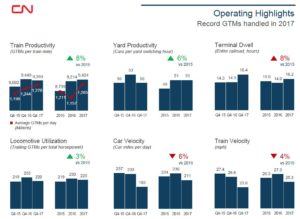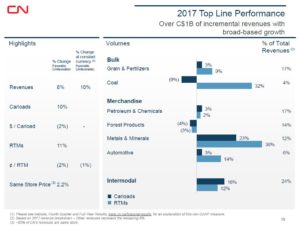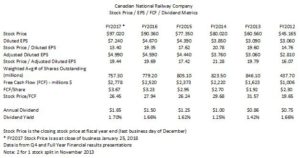Contents
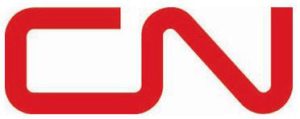
Summary
- On January 23, 2018, CNR reported diluted EPS of C$7.24 for 2017, up 55% over 2016 diluted EPS of C$4.67 and adjusted diluted EPS of C$4.99, up 9% over 2016 adjusted diluted EPS of C$4.59.
- Q4 results were impacted by challenging operating conditions, including harsh early winter weather across the network which increased the full year Operating ratio relative to 2016.
- Solid free cash flow generation of C$2.778B for 2017 exceeded 2016 FCF of $2.52B.
- CNR increased its quarterly dividend by 10% to $0.455 effective with the March 2018 quarterly payment.
NOTE: All financial results are expressed in Canadian dollars unless otherwise noted.
Introduction
Canadian National Railway (TSX: CNR) is a core holding within the FFJ Portfolio. It is also a member of the FFJ Master Stock List.
The rationale for CNR being a core component of the FFJ Portfolio is that is possesses a wide economic moat. It has significant cost advantages, extremely efficient, and is arguably the most efficient North American Class I railroad.
Business Overview
Railroads are far more fuel efficient than trucks on a per-ton mile basis. Railways quadruple the fuel efficiency per ton-mile of trucking, they have a lower carbon footprint, have far greater capacity than trucks, are less labor intensive, provide superior on-time performance, and reduce highway congestion.
Railroads are also the only practical method of transporting bulk commodities where there are no rivers for barging.
In 1980, the Staggers Act changed the face of the industry. At the time, there were more than 40 Class I railroad operators. Today, the only major Class I railways in the US and Canada are:
- Canadian National Railway (CNR)
- Canadian Pacific (CP)
- BNSF (owned by Berkshire Hathaway)
- Union Pacific (UNP)
- Norfolk Southern (NSC)
- CSX Corporation (CSX)
- Kansas City Southern (KSU)
The Class I railroads account for ~69% of U.S. freight rail mileage and 90% percent of employees. They also operate in 44 states across the US and concentrate largely on long-haul intercity traffic.
The Staggers Act allowed private contracts and rate setting. On all but the busiest lanes there is generally a single railroad which serves an end-of-the-line shipper. In North America, only two railroads operate in most regions.
CNR is a unique Class I railroad with an advantage in that its network is T-shaped. It spans Canada from east to west and it stretches from north to south in the Midwestern United States.
An additional barrier to entry is that a railroad requires a massive upfront investment and continuous major capital expenditures. As an example, CNR indicated on its January 23, 2018 conference call that:
- in fiscal 2017 it incurred net capital expenditures of ~$2.673B;
- it would be acquiring 200 locomotives over the next 3 years of which 60 would be delivered in 2018.
- Its 2018 capital program calls for:
- ~$3.2B to be spent on improving the safety and efficiency of its network which will include:
- ~$0.7B for investments to increase capacity, including the previously noted acquisition of 60 new locomotives, track infrastructure expansion, and improvements at intermodal terminals;
- ~ $1.6B for track infrastructure maintenance supporting safety and efficiency;
- ~$0.4B for continued installation of Positive Train Control (PTC) along 3,500 route miles of its U.S. network. CNR plans to invest a total of US$1.4B on PTC capital expenditures by 2020. PTC is an advanced system designed to automatically stop a train before certain accidents occur. It is designed to prevent train to train collisions and derailments caused by excessive train speed;
- Double track and siding extensions in the West Coast to Chicago corridors;
- Intermodal equipment and infrastructure in Toronto, Memphis, Tenn., Joliet, Ill., and other terminals
- Continued hiring to accommodate growth. This includes ~400 new fully qualified conductors in Q1 2018.
- ~$3.2B to be spent on improving the safety and efficiency of its network which will include:
CNR’s investment in network-related components such as sidings and double track allows it to safely and efficiently increase train links and tonnage at a rate to accommodate growth at a low incremental cost without the need to necessarily introduce additional trains.
Milton Logistics Hub (MLH)
In my October 27, 2017 post, I touched upon the MLH. Further details on this initiative and the reasoning for the need of this new hub can be found here.
Q4 and FY2017 Financial Results
CNR released its Q4 and FY2017 results on January 23, 2018.
In Q4, CNR experienced very challenging operating conditions. At the same time as it had record workload levels in key segments such as Western Canada and the U.S. Midwest, CNR encountered a series of outages on its main line and very cold December weather across the entire network. This reduced train and car velocity and increased terminal dwell.
CNR reported a 60.4% Operating ratio in Q4 2017 versus 56.6% in Q4 2016. The higher Operating ratio in Q4 resulted in the full year Operating ratio of 57.4% versus 55.9% in 2016.
The operating ratio is a major measure of profitability in the railroad industry. It is essentially a railroad’s operating expenses as a percentage of revenue; the lower the ratio, the better.
CNR typically has a superior Operating ratio than its Class I competitors.
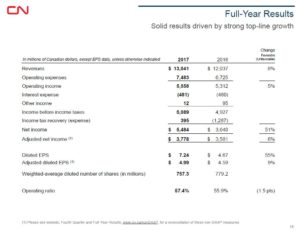 NOTE: GTMs is traffic workload
NOTE: GTMs is traffic workload
Source: FY2017 Analyst Presentation
CNR reports its earnings in Canadian dollars. A large portion of its revenues and expenses, however, is denominated in U.S. dollars. The FX fluctuation affects the conversion of the Company's U.S.-dollar-denominated revenues and expenses. On a constant currency basis, CNR’s net income for the 3 months and year ended December 31, 2017 would have been higher by C$0.026B (C$0.03/diluted share) and C$0.042B (C$0.06/diluted share).
Economic Outlook
On the January 23, 2018 analyst call, management expressed optimism for 2018.
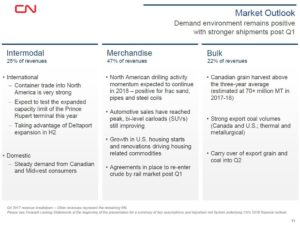 Source: FY2017 Analyst Presentation
Source: FY2017 Analyst Presentation
Volume growth in the 3% - 5% range is expected in 2018 although volatility in a number of commodity sectors is expected to persist. In addition, overall price increases should exceed inflation.
North American economic conditions are expected to remain supportive with continued favorable consumer confidence supporting growth in many sectors. While energy markets (eg. frac sand, crude and steel) demonstrated strong growth in 2017, CNR expects more moderate growth in 2018.
CNR also expects a ~25% effective tax rate versus 26% in 2017.
Valuation
Various valuation metrics using FY2017 results and the January 25, 2018 closing stock price can be found below.
On the January 23, 2018 investor conference call, management indicated it has set an adjusted diluted EPS target range of C$5.25 - C$5.40 versus C$4.99 in 2017. Using the January 25, 2018 $97.02 closing stock price, we get a forward adjusted diluted EPS ratio range of ~18 - ~18.5. This level is superior to that reported in the previous 2 fiscal years.
Dividend, Dividend Yield and Dividend Payout Ratio
On January 23, 2018, CNR announced that its Board of Directors had approved a 10% increase in the 2018 dividend on the outstanding common shares. The new quarterly dividend of CDN$0.455 will be paid on March 29, 2018 to shareholders of record at the close of business on March 8, 2018. This keeps CNR’s string of annual dividend increases intact subsequent to becoming a publicly traded entity more than 20 years ago.
The $0.455 quarterly / $1.78 annual dividend represents a ~1.83% dividend yield based on the $97.02 January 25, 2018 closing stock price. This dividend yield is several basis points higher than that reflected as at fiscal year end in 2012 – 2017.
Based on the adjusted diluted EPS target range of C$5.25 - C$5.40 for FY2018, the dividend payout ratio is ~33% - ~34%.
CN Rail - Final Thoughts
CNR’s stock price has retraced from a high of ~$106 set early January 2018. In my October 27, 2017 post I indicated an entry point in the low $90s would be attractive. Given the recently announced results and the 10% dividend increase, I view the current level of $97.02 as attractive.
I have purchased an additional 400 shares of CNR.
Thanks for reading!
Note: Thanks for reading this article. Please send any feedback, corrections, or questions to [email protected].
Disclaimer: I have no knowledge of your individual circumstances and am not providing individualized advice or recommendations. I encourage you not to make any investment decision without conducting your own research and due diligence, and consulting your financial advisor about your specific situation.
Disclosure: I am long CNR.
I wrote this article myself and it expresses my own opinions. I am not receiving compensation for it and have no business relationship with any company whose stock is mentioned in this article.


